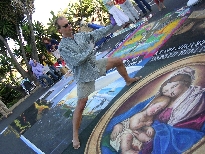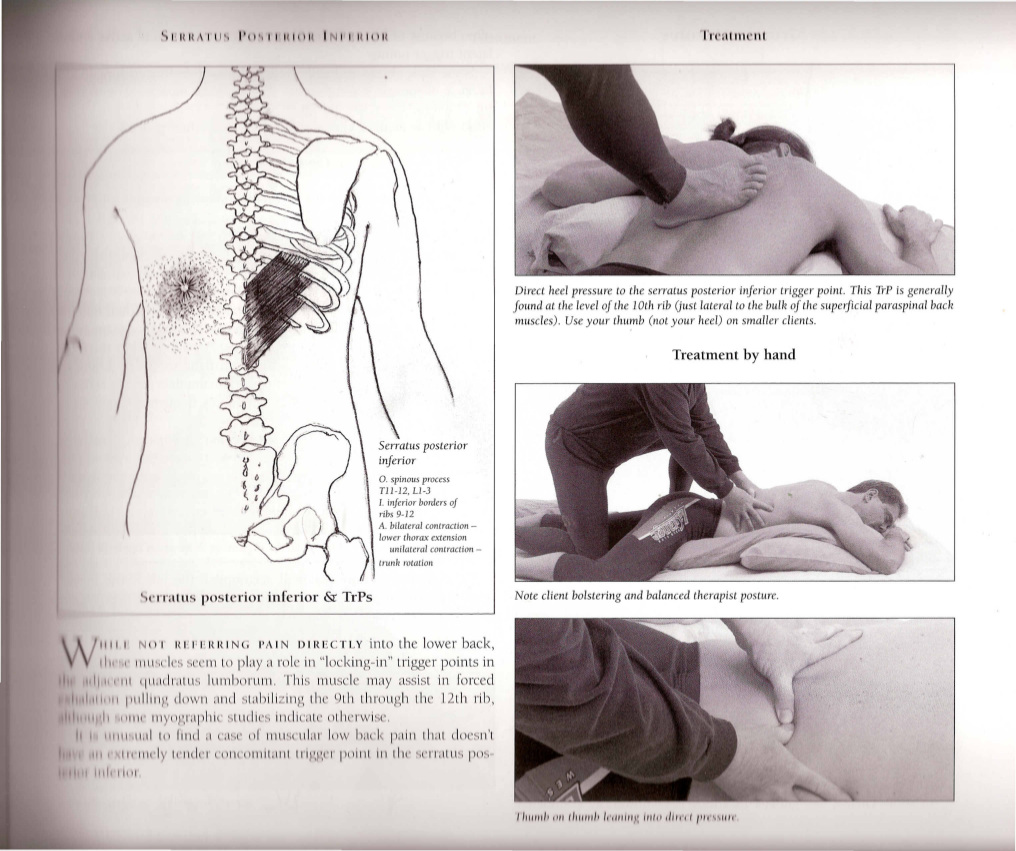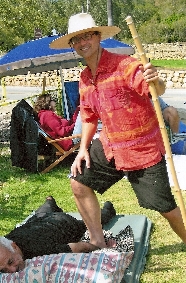
Trisoma® Taichicise™

Tai Chi Gong
... is our blend of Tai Chi and Qi Gong practices, also incorporated into our fitness exercise and yoga practice. Tai Chi is a Western common name for Taiji Chuan (or Tài jí, 太极 ), Tai chi involves integrated physical postures and transitions, focused attention, and controlled breathing. Tai chi is one of the hundreds of forms of qigong exercises that was developed in China as an ancient martial art, but over the years it has become more focused on health promotion and rehabilitation. Tai chi involves integrated physical postures, focused attention, and controlled breathing. Qi Gong, Qì gōng, or 气功 , pronounced “chi gong,” was developed in China thousands of years ago as part of traditional Chinese medicine. It involves using exercises to optimize energy within the body, mind, and spirit, with the goal of improving and maintaining health and well-being. Qigong has both psychological and physical components and involves the regulation of the mind, breath, and body’s movement and posture. [1] ---------------------------- "Qigong: What You Need To Know" National Institutes of Health U.S. Department of Health & Human Services https://www.nccih.nih.gov/health/qigong-what-you-need-to-know accessed 04/10/2024 need 301 redirect from www
Tai Chi and Qi Gong are recommended as Complementary Medicine
... by major US hospitals.
Trisoma® Yoga integrates these into Taichicise™, an easy to learn exercise modality, which requires no mat, no tools, yet can relax, invigorate and strengthen the body and mind.
More than 20 research papers have been published allowing Qi Gong to break out of the pseudoscientific realm to complement modern Western medical practice.
[1,2,3,6]
Feel free to browse the videos on this site to experience these exercises, and click on footnotes to read more.
Tai Ji Chuan is the most widely practiced martial art in the world
...and many types have solo and partner forms with or without weapons, and vary from slow moving meditation (such as Kuang Ping) to competitive forms, such as Wushu competition form combined from Sun, Wu, Chen, and Yang styles in 1989. Differences in speed, and level and width of stance of the different styles can vary this practice from non-impact, pacific meditation to acrobatic, aerobic exercise to combat martial art, for which it was originally created.
A basic tenet of all internal martial arts is that correct motion is born of absolute mental stillness and intent, thus basics are learned in slow style. The goal of training is to cultivate a kind of 'whole body' power and control, generated from "the bottom up," meaning the stronger muscles of the legs and hip serve as the seat of power. This is described as "being rooted in the feet, developed by the legs, directed by the waist transferred through the back and expressed in the hands." The body held in a state of dynamic relaxation allows the power of the whole body to flow out of the hands and into the opponent without obstruction. In combat, using brute force is strictly discouraged, and the goal is to develop sensitivity to avoid the opponent's power and apply one's own whole body power where the opponent is most vulnerable: "stick, adhere, continue and follow (zhan, nian, lian, sui)", smothering the others' power and destroying their balance, similar to judo practice. Techniques that include pushing, pulling, wrapping, bumping, sweeping, stamping, locking, jumping, airborne spinning, knocking down, throwing (grappling) and being thrown far outnumber striking and kicking techniques.
The origin of Taiji is purported to be 5000 years ago, but not verifiable until Chen Wangting (1600-1680) of Henan province, China, codified the martial art training practice of seven routines. The other four modern orthodox family styles of tai chi chuan are traced to the teachings in the Chen clan village in the early 19th century.[4,5] The Mandarin term "t'ai chi ch'uan" literally translates as "supreme ultimate fist", "boundless fist," or "great extremes boxing" (note that 'chi' in this instance is an earlier romanization of modern 'ji', not to be confused with the use of 'chi' in the sense of 'life-force' or 'energy', which is an earlier romanization of modern 'qi'). Alternate Western names for Tài Jí Quán are Tai Ji Quan, Taijiquan and Tai Chi Chuan.
Qi Gong is a practice of health maintenance, therapeutic intervention (in Chinese medicine), spiritual path and/or component of Chinese martial arts. Qi Gong meditation is said to have begun when the Yi Jing - Book of Changes was introduced to China, sometime before 1122 B.C., and to then qigong meditation continued until the Han dynasty (206 B.C.) when Buddhism and its meditation methods were imported from India. Qi Gong survived the Communist Mao years as a private practice to cultivate health and virtue. Chi Gong, Chi Kung, Qi Kung, Qigong or Qi Gong translate to "energy practice". Qi, or Chi, means breath or air in Chinese, and, by extension, 'life force', 'energy' or even 'cosmic breath'. Gong means practice.
Paul trained in Kuang Ping Tai Chi in 1994 with Valarie Prince Gabel, and picked up some Qi Gong with Michael Gibian and Katie Mickey and Matthew Jones and other instructors. Paul incorporates Tai Chi and Qi Gong into Trisoma's yoga practice, and for specific training refers clients to local instructors, such as Michael Gibian, Roger Jahnke and Gerry Marr.
Following are some links to Tai Chi and Chi Gong information:
|
Four minute relaxation video by Dr. Roger Jahnke:
|
Tai Chi - Yang 24 Simplified Videos:
|
Gracefully Performed demonstrations:
|
Wudang wushu:
|
|
Taiji Form 24 instruction video:
|
Taiji Form 108 instruction video:
|
Taiji Quan (Miyaoka Ai)
2007 Sport Competition: |
Chang Quan (Ichikizaki Daisuke)
2007 All-Japanese Wushu Taiji Championships Sport Competition: |


"clothes on, no oil, pain gone™"
No oil is used and clients remain loosely clothed- no jeans, please.
History
Research
References
1.
Fred Kenyon & John Harris,
Fix Pain: Bodywork Protocols for Myofascial Pain Syndromes
© 2002, Press4Health Press
(Return to Reference 1 in text)
References
1.
Xin Yan, Hua Shenb, Hongjian Jiangc, Chengsheng Zhangd, Dan Hud, Jun Wangb and Xinqi Wue;
External Qi of Yan Xin Qigong differentially regulates the Akt and extracellular signal-regulated kinase pathways and is cytotoxic to cancer cells but not to normal cells,
The International Journal of Biochemistry & Cell Biology, Volume 38, Issue 12, 2006, Pages 2102-2113.
(Return to Reference 1 in text)
2.
Zhen-Qin Xia (School of Medicine, University of California at San Diego), Hua Shen (New Medicine Science Research Institute), Alexis Traynor-Kaplan (School of Medicine, University of California at San Diego)
External Qi of Yan Xin Life Science Technology Can Revive or Suppress Enzyme Activity of Phosphatidylinositol 3-Kinase
Xin Yan
Bulletin of Science, Technology & Society, Vol. 22, No. 5, 403-406 (2002)
DOI: 10.1177/027046702237270,
Chongqing Institute of Traditional Chinese Medicine/New Medicine Science Research Institute.
ABSTRACT: Phosphatidylinositol 3 kinase (PI 3-kinase) is an important enzyme that is involved in the regulation of a variety of biological processes such as apoptosis, celldivision, and ion channel activity and can play a role in the pathological development of a number of diseases, including AIDS and cancer. The authors' data indicate that external qi of Yan Xin Life Science Technology(YXLST) can modulate enzyme activity in two directions. Within a time window of 3 days of the initial emission of external qi of YXLST, PI 3-kinase activity was restored in an outdated enzyme sample that had lost activity, and PI 3-kinase activity was suppressed in a freshly purified sample relative to an untreated control sample so that its activity was nearly undetectable. The data presented are consistent with the hypothesis that external qi of YXLST can alter molecular events. The uniqueness of this and other observations mandates further study.
(Return to Reference 2 in text)
3.
Xin Yan (Chongqing Institue of Traditional Chinese Medicine, Chongqing, China),
Feng Lu (Reference, Inc., Boston, MA, 02110),
Hongjian Jiang (Massachusetts General Hospital, Boston, MA, 02114),
et al.
Certain Physical Manifestation and Effects of External Qi of Yan Xin Life Science Technology
Journal for Scientific Exploration
Volume 16: Number 3: Article 4.
ABSTRACT: This paper reviews a portion of the data generated via the external qi emitted by Dr. Yan Xin. Included here are (1) strong responses developed in LiF thermoluminescent dosimeters, (2) strong responses in aqueous solution structure as probed with laser Raman spectroscopy and (3) alterations in the half-life of 241Am as probed with both Y-ray spectroscopy and a solid-state nuclear track detector. According to the different circumstances, external qi of Dr. Yan Xin can display different attributes such as being distance transcending, bidirectional, reversible, or targeting. Although external qi of Yan Xin Life Science Technology has not been identified with any of the four known and accepted fundamental physical forces, its influence on physical reality is robustly confirmed.
(Return to Reference 3 in text)
4.
Wile, Douglas (1995).
Lost T'ai-chi Classics from the Late Ch'ing Dynasty (Chinese Philosophy and Culture).
State University of New York Press. ISBN 978-0791426548.
(Return to Reference 4 in text)
5.
Wile, Douglas (1983).
Tai Chi Touchstones: Yang Family Secret Transmissions.
Sweet Ch'i Press. ISBN 978-0912059013.
(Return to Reference 5 in text)
6.
Chien-Hui Liou3,4, Chang-Wei Hsieh3,4, Chao-Hsien Hsieh3, Chi-Hong Wang3,5, Si-Chen Lee6 and Jyh-Horng Chen3
[(3) - Interdisciplinary MRI/MRS Lab, Department of Electrical Engineering, National Taiwan University, Taiwan, ROC;
(4) - Anthropo-Celestial Research Institute, The Tienti Teachings, Taiwan, ROC;
(5) - Department of Neurology, Cardinal Tien Hospital Yung Ho Branch, Taiwan, ROC;
(6) - Department of Electrical Engineering, National Taiwan University, Taiwan, ROC]
(2006).
Forced and Non-forced Chinese Meditation Studies.
IFMBE Proceedings, World Congress on Medical Physics and Biomedical Engineering 2006, August 27 – September 1, 2006 COEX Seoul, Korea “Imaging the Future Medicine”
10.1007/978-3-540-36841-0_911, R. Magjarevic and J. H. Nagel.
Abstract -
There exist many different types of meditation. The mechanism why meditation improves people’s health remains unclear. Since
different meditations may activate different regions in brain, we can use functional magnetic resonance imaging (fMRI) to investigate it. We may simply divide meditation into two different types, which is forced meditation (FM) and non-forced meditation (NFM). The FM type may keep a phrase in mind, observe breathing, proceed mind imaging or any other actions to keep people’s attention focused. Chinese original quiet sitting (COQS) is mainly one kind of traditional Chinese meditation. It contains two different parts: a short period of keeping phrase and receiving spiritual energy, and a long period of relaxation with no further action. The second part of it is really what we called “non-forced” type, whereas the first part is normally a forced one. In this paper, we want to find out the brain activation area precisely during FM and NFM. We studied the observing breathing meditation (OBM) and the first part of COQS as the FM type, and also studied the second part of COQS as NFM type. Our experimental results showed very different activation patterns among the brain between FM and NFM. The BOLD (Blood Oxygenation Level Dependent) signal changes had also been found. The posterior cingulated gyrus showed strong activation in OBM, the pineal gland and hypothalamus showed positive activation in the first and second stage of COQS separately. From our results, we found the basic meaning of the mechanism why meditation improves people’s health.
(Return to Reference 6 in text)
Images
1.
Ph
oto photo of barefoot therapy on upper trapezius
© Fix Pain, used with permission
(Return to Image 1 in text)
Images
1.
2004 by John Harris
2. & 3.
2005 by Delphine Louie